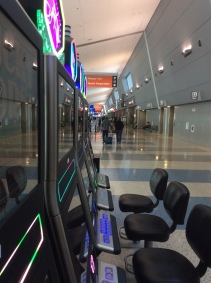
“We need the Intelligence Augmenter, stat!
“The diagnostic algorithm’s out of whack and the Transition Specialist wants to know how the interface outflow is correlating the patient’s Fitbit data into the Director of Decentralized Asset Management’s new discharge interface. And we can’t reach the Business Analyst for Patient Workflow.”
The above is not a conversation you are likely to have heard in your hospital lately.
But if you listen to Mark Casselman (@markcasselman), the CEO of COACH (@COACH_HI), Canada’s Health Informatics Association, it is the type of exchange that could be a reality in the not too distant future.
In a recent address at the #HIMSS16 conference in Las Vegas, Casselman gave a thoughtful overview of how the changing landscape around how digital health care is going to fundamentally change not only how care is provided to patients but also the roles and responsibilities of those providing that care.
Casselman noted we are currently in an environment where we have two distinct health care delivery ecosystems working simultaneously – the traditional health care delivery system based on face-to-face interactions between provider and patient in either an office or hospital setting, and the new and evolving consumer-based digital health system – the world of virtual care, apps, engaged patients and the quantified self.
“The traditional health care delivery ecosystem is mostly operating distinctly and differently from these fantastic innovations. They’re operating at different clock speeds.”
He notes that virtual care is evolving along the whole continuum from the traditional clinician/patient interface through team-based care to the new personalized patient-centred approach to care.
“It’s almost impossible for these things to be embedded in the traditional system because they’re changing so quickly,” he said.
These evolving forms of digital care and the underlying beliefs and concepts that support them are creating dynamic tension for those used to working in the traditional health care environment.
In part, he said, this is because the traditional evidence-based model of care which relies on the randomized controlled trial as the gold standard, cannot adapt quickly enough to assess and absorb the changes being brought about by digital health innovations.
To Casselman – and seemingly to the 42,000 delegates to the Vegas meeting – the new reality is one Canadian physicians, hospital administrators and all others employed in the system must start to acknowledge.
“Health care professionals, teams, and organizations must consider what novel skills and capabilities are needed to deliver virtual care effectively,” he said.
Casselman’s organization – COACH (one of the main sponsoring bodies of the upcoming #ehealth2016 conference in Vancouver) has done much to define the 65 existing roles and responsibilities involved in health informatics in Canada today and as developed a professional skills matrix for those roles.
But with the emerging digital health world, he said, there is now a need to re-examine this and determine the new roles that will be needed to provide care in the new world of health delivery.
Using artificial intelligence to augment care with algorithms, harvesting big data for insight, precision medicine, and digital care provided through mobile in the home and the community will require many different skills sets and roles –the type of currently fictitious roles noted by Casselman in my introductory vignette.
But Casselman goes beyond this onto more dangerous ground when he questions whether the patient electronic record of the future will even be the primary point around which patient care will be focused
“We’re digitizing our physiological indicators, we’re sharing them and its creating a real tension in the world of health informatics,” he noted.
Maybe the physician-owned patient record in the EMR is only a segment of what will really be needed to deliver care in the future as the patient tracks his or her own indicators and brings this to the table.
Much to think about and we can only be thankful that Canadian informatics leaders such as Casselman are giving it some thought, especially when he prefixes it all by stating “At the end of the day, it’s all about the care.”
(The summary sides from Casselman’s full presentation can be accessed here).


![HIMSS16 SMA Badge [8339409]](https://prich5757.files.wordpress.com/2016/01/himss16-sma-badge-8339409.png?w=224&h=266)



![HIMSS16 SMA Badge [8339409]](https://prich5757.files.wordpress.com/2016/01/himss16-sma-badge-8339409.png?w=147&h=175)